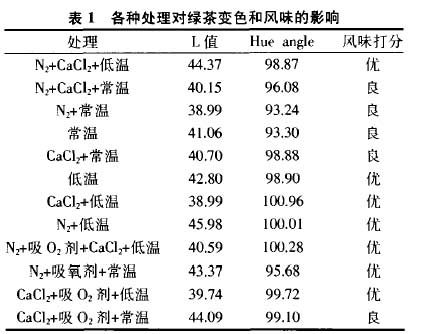Green tea is a famous specialty product in Zhejiang Province. Although the product's shelf life is good, it generally appears that after l-2 months, the green color turns brown and the fragrance disappears, and it gradually becomes Chen tea. Japan has a dedicated cold store for tea storage. Decreasing the moisture content of green tea helps to preserve green tea. Japan reported that the oxygen content was stored below 5%, which had a significant effect on maintaining the quality of green tea. The amount of oxygen contained in N2 was reduced to l%, which can effectively guarantee the quality of green tea. This experiment mainly studies what kind of means is the key means, so as to avoid the application of all means of preservation and reduce the application cost.
1 Materials and Methods:
experimental method:
The tea is Xijing Longjing, which was purchased on May 4, 1998 in Hangzhou market. It was measured on July 1, 1999. The following orthogonal treatment: 1.1 tea 100g, pumped N2, and placed in paper packaging anhydrous CaC1 absorbent 2.5g, sealed with aluminum platinum composite bag, a 18 °C frozen. 1.2 tea lOOg, pumped N2, and put a paper sheet anhydrous CaC1 absorbent 2.5g, sealed with aluminum platinum composite bag, stored at room temperature. 1.3 tea lOOg, pumped N2, sealed with aluminum and platinum composite bag, room temperature storage.
1.4 tea lOOg, sealed with aluminum platinum composite bag, stored at room temperature.
1.5 tea lOOg, water-free CaC1 water absorbent packaged in paper
2.5g, sealed with aluminum platinum composite bag, stored at room temperature.
1.6 tea lOOg, sealed with aluminum and platinum composite bag, frozen at 18 °C.
1.7 tea lOOg, 2.5 g of water-absorbing CaC1 water-absorbing agent packed in paper, sealed with aluminum platinum composite bag, and frozen at 18°C.
1.8 Tea 100g, pumped N2, sealed with aluminum-platinum composite bag and frozen at 18°C.
1.9 tea lOOg, pumped N2, built-in paper packaging anhydrous Ca-Cl2 absorbent 2.5g, built-in suction 0 agent lg (made by China Tea Research Institute), sealed with aluminum platinum composite bag, a 18 °C Frozen under.
1.10 tea lOOg, pumped N2, built-in suction 02 agent lg, sealed with aluminum and platinum composite bag, a frozen at 18 °C.
1.11 tea lOOg, built-in paper packaging anhydrous CaC1 water absorbent 2.5g, built-in absorption 02 1g, sealed with aluminum platinum composite bag, a frozen at l8 °C.
1.12 100 g of tea leaves, 2.5 g of water-absorbing CaC1 water-absorbing agent packed in paper, and 1 g of moisture-absorbing agent, sealed in an aluminum-platinum composite bag and stored at room temperature.
Measurement method: Hue angle value and lightness value L value were measured with a colorimeter.
2 Results and Analysis
Excellent: The flavor is normal and strong, and the taste is good. Good: Slight scent, taste good.

From Table 1, it can be seen that the low-temperature storage tea has the highest Hue an value of more than 98, and the higher the Hue ae value, the greener the color. The Hue an output stored at room temperature is relatively low. Adding water-absorbing agent, charging N2, and adding 02 at low temperature have no obvious effect on the increase of Hue ae value. Stored at room temperature, adding water absorbent CaCI ~, its Hue ae value is relatively improved, which confirms the effectiveness of adding water absorbent at room temperature. The addition of N2 and oxygen absorbers has a very limited effect on Hue ae. The L value represents the lightness of the tea, and the lower the L value, the more severe the browning. The effect of various treatments on the L value is not observed. It shows that this value is affected little by the treatment, but by the sample itself, the image II is larger. This may be related to the enzymatic operation. From the point of view of quality, cold-temperature refrigerated green tea won the best, followed by water absorbent treatment. Due to N2 packaging, inhalation can cause tea breaks and affect shape. Adding 02 to the treatment at room temperature has only a few benefits for the Hue and L values. There are certain benefits to the flavor.
3 Conclusion:
3.1 Cold storage is the best method for storing green tea, and it is not possible to store it during storage.
3.2 Store green tea at room temperature, should add water absorbent.
3.3 It is not necessary to charge N2 in the sealed package at room temperature.
3.4 Oxygen absorbers in sealed packages at room temperature have little benefit to the preservation of the wind.
Wang Xiangyang, Food Science and Technology Department, Zhejiang Gongshang University, Food Research and Development - No.3, 2005
Vertical Banner Printing,PVC Banner,Banner Printing
Advertising Banners,Business Cards Co., Ltd. , http://www.chsticker.com